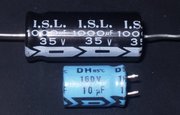Electrolytic capacitor
|
|
An electrolytic capacitor is a type of capacitor with a larger capacitance per unit volume than other types, making them valuable in relatively high-current and low-frequency electrical circuits. This is especially the case in power-supply filters, where they store charge needed to moderate output voltage and current fluctuations, in rectifier output, and especially in the absence of rechargeable batteries that can provide similar low-frequency current capacity. They are also widely used as coupling capacitors in circuits where AC should be conducted but DC should not; the large value of the capacitance allows them to carry very low frequencies without carrying DC.
| Contents |
Construction
Electrolytic capacitors are constructed from two conducting aluminium foils, one of which is coated with an insulating oxide layer, and a paper spacer soaked in electrolyte. The foil insulated by the oxide layer is the anode while the liquid electrolyte and the second foil act as cathode. The aluminium oxide layer is the dielectric, and the thinness of this layer, along with its ability to withstand an electric field strength of the order of 109 volts per metre, is what produces the high capacitance. This stack is then rolled up, fitted with pin connectors and placed in a cylindrical aluminium casing. (The two most popular geometries are axial leads coming from the center of each circular face of the cylinder, or two leads or lugs on one of the circular faces. Both of these are shown in the picture.)
The electrolyte is usually boric acid or sodium borate in water with some sugars or ethylene glycol added to retard evaporation. While you should not eat this, nor get it in your eyes, it is not very corrosive or dangerous. Simply wash it off your skin after coming into contact with it.
Wet-slug tantalum electrolytics do contain sulfuric acid. These are more expensive than aluminum-based capacitors, and generally only usable at low voltage, but they boast much higher capacitance per unit volume and thus are popular in miniature applications such as cellular telephones.
It is important, however, to always be careful and not take chances. Safety glasses are always advised. With chemicals, extra precaution is always worthwhile.
Electrolytic capacitors have a polarity, unlike most capacitors. This is due to the fact that the aluminum oxide is held in place by the electric field, and when reverse-biased, dissolves into the electrolyte. This allows a short circuit between the electrolyte and the aluminum. The liquid heats up and the capacitor may explode.
This is the only reason for the polarity requirement. They will behave like any other capacitor if reverse biased, up to the point that they are destroyed. Most survive fine with no DC bias or with only AC, and can even withstand a reverse bias for a period of time, but circuits should be designed so that there is not a constant reverse bias for any significant amount of time. A constant forward bias also increases the life of the capacitors.
Modern capacitors have a safety valve on one circular face to vent the hot gas/liquid, but the rupture is still loud. The correct polarity is indicated on the packaging by a stripe with minus signs and possibly arrowheads, indicating the lead that should be more negative than the other.
Some capacitors exhibit the inverse effect as well; when kept forward biased, the aluminum oxide layer is replenished, fixing short circuits. These capacitors are referred to as "self-healing".
Electrical behavior
A common modelling circuit for an electrolytic capacitor has the following schematic:
where Rleakage is the leakage resistance, RESR is the equivalent series resistance, LESL the equivalent series inductance (L being the conventional symbol for inductance).
RESR must be as small as possible since it determines the loss power when the capacitor is used to smooth voltage. Loss power scales linearly with the ripple current flowing through and quadratically with RESR. Low ESR capacitors are imperative for high efficiencies in power supplies.
It should be pointed out that this is only a simple model and does not include all the effects associated with real electrolytic capacitors.
Since the electrolytes evaporate, design life is most often rated in hours at a set temperature. For example, typically as 2000 hours at 105 degrees Celsius (which is the highest working temperature). Design life doubles for each 10 degrees lower, reaching 15 years at 45 degrees.
See also
- Electrolytic capacitor value
- Capacitor Plague (premature failure of some electrolytic capacitors)
External link
- Electrolytic Capacitors (http://www.powerdesigners.com/InfoWeb/design_center/Design_Tips/Electrolytics/Caps.shtm)de:Elektrolytkondensator


